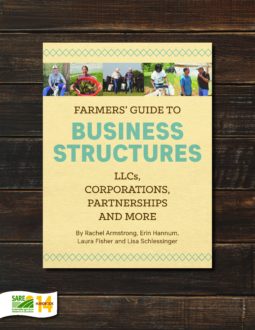This section provides farmers with tools to help choose the best business entity for their farm operation: Entity Comparison Chart and Choose Your Entity Flowchart. Consciously choosing an entity is the first and probably most important step in running a successful farm operation.
These charts will help farmers narrow down the options based on certain factors or characteristics of the business entity.
Warning: Are you already a corporation?
If you are already a corporation, don’t do anything until and unless you consult a tax professional. There can be serious tax implications when changing to another entity. While it can still be useful to go through the process of determining the best entity for you, if you decide on another entity, be sure you consult with your accountant or tax attorney before switching.
| Entity Comparison Chart | |||||||||
|---|---|---|---|---|---|---|---|---|---|
| LLC | C Corp | B Corp | S Corp | Cooperative | Non- Profit | Sole Proprietor | General Partnership | ||
| Formalities and Structure | Organizing document is required | X | X | X | X | X | |||
| Annual meetings are required | X | X | X | X | X | ||||
| One owner is okay | X | X | X | X | X | ||||
| Benefits | Can sell or transfer entity to others | X | X | X | X | X | |||
| Personal liability is protected | X | X | X | X | X | X | |||
| Owners can make a profit | X | X | X | X | X | X | X | ||
| Can prioritize a social purpose over making profits | X | X | X | X | X | X | X | ||
| Tax Implications | Entity does not have to pay taxes (pass-through) | X | X | X | X | ||||
| Potential self-employment tax savings | X | ||||||||
| Potential to be tax exempt | X | ||||||||
| Potential for donors to receive a tax deduction | X | ||||||||
| Potential for favorable tax deductions on business entity’s earnings | X | ||||||||
To see the Flowchart, Download the PDF of Business Structures and refer to page 25
Next Steps
The section that follows includes chapters on each of the main entities: sole proprietorship and general partnership, LLC, C corporation, S corporation, B corporation, cooperative, and nonprofit (incorporated and unincorporated). Once you have narrowed down your choice by using the above charts, the next step is to review the entity-specific chapter (or chapters if you’re still narrowing it down from two or three options). These chapters can help you affirm your decision, as they will give you a more thorough understanding of the characteristics, benefits, drawbacks and requirements for that particular entity. These chapters also include detailed information and tools such as checklists and sample agreements to guide you through the process of forming, organizing and implementing your business entity of choice.
